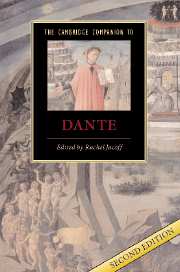Book contents
- Frontmatter
- 1 Life of Dante
- 2 Dante and the lyric past
- 3 Approaching the Vita nuova
- 4 From auctor to author: Dante before the Commedia
- 5 Introduction to Inferno
- 6 Introduction to Purgatorio
- 7 Introduction to Paradiso
- 8 Dante and the Bible
- 9 Dante and the classical poets
- 10 Allegory and autobiography
- 11 A poetics of chaos and harmony
- 12 The theology of the Comedy
- 13 The poetry and poetics of the creation
- 14 Dante and Florence
- 15 Dante and the empire
- 16 Dante and his commentators
- 17 Dante in English
- Further reading
- Index
- Series List
6 - Introduction to Purgatorio
Published online by Cambridge University Press: 28 May 2007
- Frontmatter
- 1 Life of Dante
- 2 Dante and the lyric past
- 3 Approaching the Vita nuova
- 4 From auctor to author: Dante before the Commedia
- 5 Introduction to Inferno
- 6 Introduction to Purgatorio
- 7 Introduction to Paradiso
- 8 Dante and the Bible
- 9 Dante and the classical poets
- 10 Allegory and autobiography
- 11 A poetics of chaos and harmony
- 12 The theology of the Comedy
- 13 The poetry and poetics of the creation
- 14 Dante and Florence
- 15 Dante and the empire
- 16 Dante and his commentators
- 17 Dante in English
- Further reading
- Index
- Series List
Summary
Of the three otherworldly kingdoms which the Divina Commedia represents, Purgatory is Dante's most original creation. Hell and Paradise were already well-established places within the medieval imagination. Each possessed a standard set of topographic and iconographic attributes which, accrued in the course of many centuries of patristic tradition, rendered them instantly recognizable to prince and pauper alike. Hell was a dark, subterranean place where eternal torments were administered by demons under the guidance of Satan, the ruler of the underworld. Paradise was Hell's positive counterpart: a luminous celestial palace where eternal blessings were administered by the angels under the guidance of God, the emperor of the universe. In both cases the author of the Commedia felt called upon less to alter preexisting traditions, than to extend and systematize them: establishing, for instance, a much more precise hierarchy of the degrees of damnation or blessedness endured or enjoyed by souls in the afterlife; and finding a place for specifically Christian categories of error, like heresy, within an Aristotelian moral system.
But as regards the intermediate realm between Paradise and Hell, the visual, literary, and patristic precedents were far less rich. Christian theologians had long recognized that there existed a logical necessity for a place in between Hell's eternal torments and Paradise's eternal beatitude. To them it seemed inconceivable that a soul like that of Buonconte da Montefeltro (Purgatorio 5), saved thanks to a single tear of contrition after a lifetime of sin, should simply be lifted up into heaven and placed in the company of the blessed without some additional purifying process.
- Type
- Chapter
- Information
- The Cambridge Companion to Dante , pp. 91 - 106Publisher: Cambridge University PressPrint publication year: 2007
- 2
- Cited by

